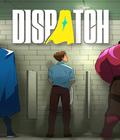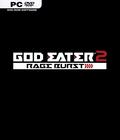God Eater debuted in North America in 2011. Released under the name Gods Eater Burst and published by D3 instead of Bandai Namco proper, the game filled the void left by the Monster Hunter series no longer being on the PSP. The title was rather good and spawned an anime series in the process. A little over five years after that release, we get God Eater 2: Rage Burst on multiple platforms, including the PC, where a Monster Hunter title exists – if you don't mind playing in Chinese. For the most part, things remain unchanged, and that's both good and bad, depending on your outlook.
The story takes place a few years after the events of the first game. You play a character of your own creation, the newest member of a special forces unit called Blood. While the world is still full of God Eaters, your unit is comprised of those who have special powers lying dormant in their blood. Your adventures still have you protecting your mobile city from the various Aragami that roam the world, but it isn't long before you're out trying to stop an Aragami-related plague that is threatening mankind.
If you're familiar with the first game or anime in general, then you pretty much know how the story progresses. You're first introduced to the quirky cast of characters either at the beginning or end of every battle. There's more time to establish relationships between one another and some time taken to see them mature a bit. There's also some time spent giving everyone slice of life moments to freshen things up. If you're aiming to get to the heart of the story, you'll be waiting a long time, as the tale is told very slowly.
The game follows a very simple loop that revolves around two main activities. The first is combat, which sees you picking a mission that usually involves the extermination of either all of the Aragami in the area or a specific one that is more powerful than the rest. You equip yourself with necessary extras, assemble your team, and go into the field to hunt Aragami. Crafting makes up the second part of the loot, as you gather elements from the battlefield and from the Aragami themselves. Those elements are then used to craft stronger materials, weapon augmentations or better weapons, to name a few.
The combat has seen some improvements from the first title. The melee weapon type selection has increased from three to six; the Boost Hammer, Charge Spear and Variant Scythe join the three different blade types from the first game. Guns vary as well, as you can choose if your melee weapon will transform into an assault rifle, blast cannon, shotgun or sniper rifle. Bullet type also plays a part, as you can augment your regular bullets into becoming infused with elemental powers. Then there are the Blood Arts, which give off powerful melee or ranged attacks or even big defensive maneuvers, depending on your play style. As before, God Eater 2 encourages you to use a combination of melee and projectile attacks to get the job done. Using your gun provides much more damage than melee with any weapon, but slashing away at a foe is the only way to replenish your ammo. It's a good balance to the system, as you won't find yourself exclusively using one type of attack to handle every monster.
While you may want to go on missions alone to up the difficulty factor, you'll come to appreciate your AI partners during tougher battles. They do a good job of mixing up their attacks and using their abilities intelligently, so you won't catch them using their Blood Arts just as a monster is dying. They're smart about using their healing items or abilities, so you're kept alive, and they do a great job of ensuring that everyone else is brought back into the fight by resurrecting them almost immediately. The fact that you can improve on some of their abilities makes them invaluable when you can't augment yourself anymore but still want to use some of the new stuff you've found.
One thing that genre veterans will find interesting is that the title is pretty forgiving if you aren't the type to use strategy while fighting the larger Aragami. Just like any other game of this type, God Eater 2 doles out more damage to a monster once you learn their elemental weakness. Should you go in with vanilla attacks, you'll still be fine even if you don't employ as much damage as expected. It makes the first few hours of the game much easier, as you'll be able to acclimate yourself to the system more easily without being overwhelmed by all of the information. By the time you reach the middle of the game, where you'll be punished for coming in with the wrong element type, you'll have enough experience to come up with more sound plans for the encounters.
Some of the issues that marred the first title are present here as well. The fighting areas are quite small, and it doesn't take very long to cover every inch of the battlefield. You'll get familiar with these stages in no time, since you'll fight through them over and over, and there are no real changes with the exception of monster types per mission. The missions never seem to take very long. Unless you fight with the bare minimum allowed for your party or bump up the difficulty, you're not going to spend much time in most stages, as a majority of them can be finished in a few minutes.
Interestingly, your view and subsequent enjoyment of God Eater 2 will be dependent on how much you enjoy God Eater: Resurrection. Aside from the obvious, the reason this gets brought up is because all of the new additions to the second game, like the expanded weapon set and some of the newer attacks, were backported to Resurrection. Buying the second game on the PC gives you the first game as well, and even though there isn't much to tie both of them together, most will be compelled to play the first game before diving into this one. As a result, there's bound to be a tinge of disappointment by the time they go into the second game and see that hardly any mechanics have changed.
One of the criticisms against many of the PSP and Vita Monster Hunter-style games was that online play was never a factor. There was always ad-hoc play, but the chances of finding enough people with PSPs or Vitas are slim, no matter where you go. God Eater 2 solves this by actually having the ability to go online and form parties, so you can either continue your game or jump into someone else's to give them a hand. Just about every option for searching is here, from password protection to how far apart you want your allies to be from your own level.
The problem is that there's no one to play with online. A little under a month has passed since the game was released, and the lobbies are barren, with no one available for at least one online mission. This means you don't have to worry much about setting up password-protected lobbies just so friends can jump into a game, but for those looking for random strangers, you're better off sticking with offline play.
Like some of the other parts of the title, the graphics in God Eater 2 will remind you of its portable roots. The characters and environments seem to sport a lower amount of polygons than expected for a modern offering, and the textures in some spots are very blurry. Some of the animations, like walking and running, can appear to be stilted in some areas, while the in-game cut scenes can sometimes feature the bare minimum in animation. Even the special effects, like bullet and melee hits, don't look as flashy as one would expect from a current game running on pretty powerful hardware. The game looks fine enough when you compare it to most other anime-style titles, regardless of genre. Aliasing is nonexistent, and the frame rate is solid, even if you turn up all the admittedly limited bells and whistles on a mid-range rig.
As far as sound goes, things are pretty good. The music is a nice blend of orchestral and modern action themes, similar to what you expect from an anime. It goes quiet on cut scenes but ramps up once you get into a fight. The effects are fine, but the sound mix in battle can use some work, as the music can sometimes overpower the speech being uttered by you and your companions. Speaking of voice, the performances are pretty good, but you'd better love English, since that's all you're getting here. There's no option for a Japanese voice track, and even the songs are in English, though done by what sounds like native Japanese speakers instead of completely new artists.
In the end, God Eater 2: Rage Burst is a good adventure game that remains accessible for genre newcomers, and the wide variety of weapons and power-ups ensures that you'll find your favorite style rather quickly. The fights aren't overly strategic, but you are rewarded if you know the weaknesses of monsters you're facing; there are tons of these fights, and each is rather short unless you pump up the difficulty. The story could be better, and it would have been nice if the online community were more active. Those coming fresh off of God Eater: Resurrection won't find much of a difference. God Eater 2 is solid enough that it comes as an easy recommendation for PC players looking for that Monster Hunter fix yet weren't quite sold on Toukiden: Kiwami.
Score: 7.5/10
More articles about God Eater 2: Rage Burst











 God Eater 2: Rage Burst continues the God Eater saga, featuring new and returning heroes, rich character and weapon customization, and over 100 hours of story and gameplay content; fully voiced in English.
God Eater 2: Rage Burst continues the God Eater saga, featuring new and returning heroes, rich character and weapon customization, and over 100 hours of story and gameplay content; fully voiced in English.















